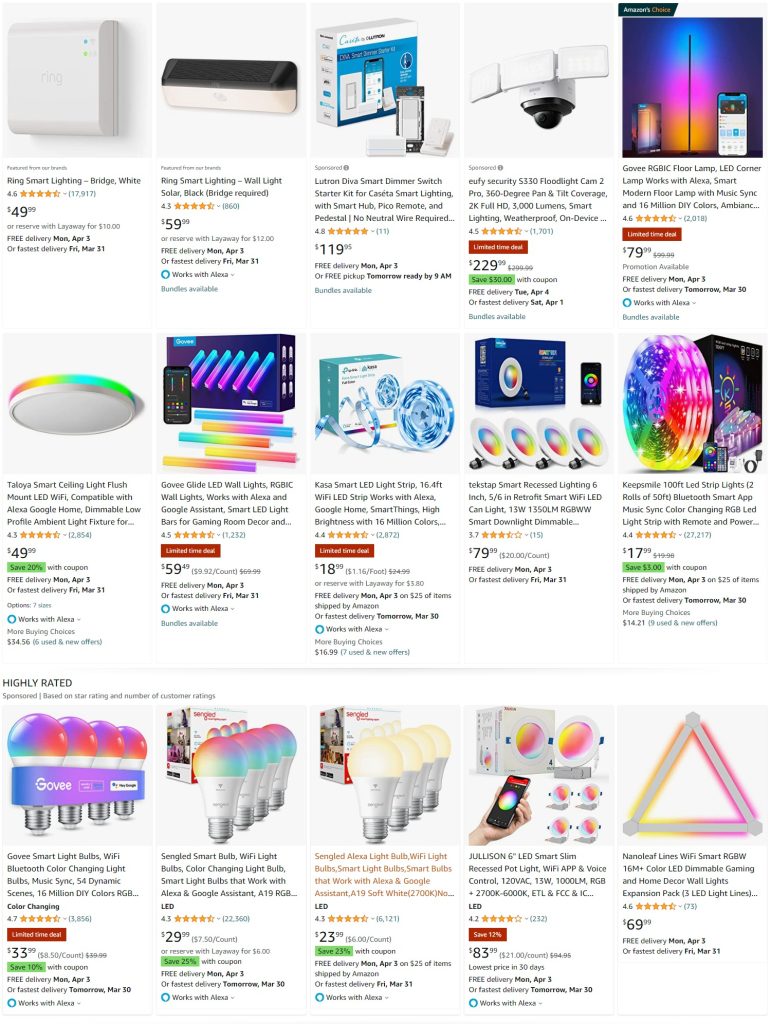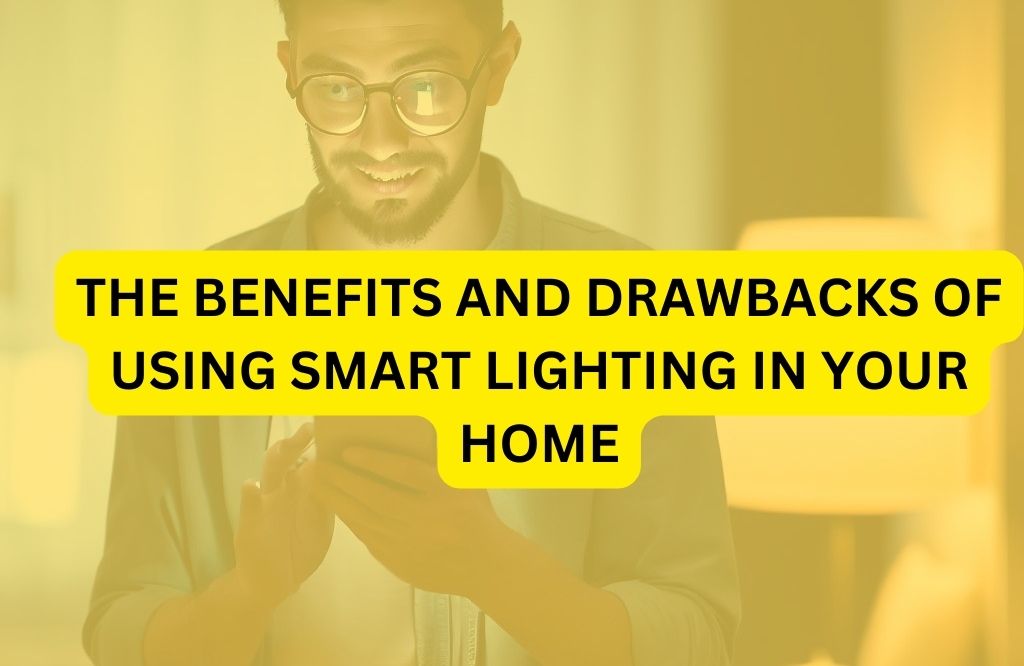Have you ever walked into a room and wished you could simply say, “Lights on,” and the room would magically illuminate? Or have you wanted to create the perfect ambiance for a movie night or dinner party with just a tap on your smartphone? With smart lighting, these scenarios are no longer a distant fantasy. As our world grows increasingly interconnected and tech-savvy, numerous homeowners are turning to the ease and efficiency offered by smart lighting systems. But is this the correct decision for your residence? In this piece, we will examine the pros and cons of smart lighting to assist you in making a well-informed choice. So, pour yourself a cup of coffee and join us as we delve into the intriguing realm of intelligent lighting.
Key Takeaways:
- Smart lighting provides energy efficiency, convenience, security, and personalization.
- LED smart bulbs are more energy-efficient and last longer than traditional bulbs.
- Remote control and smart home integration offer seamless accessibility and control.
- Customizable settings enhance ambiance and support various moods and activities.
- Drawbacks include initial costs, compatibility challenges, privacy concerns, and reliability.
- Consider needs, budget, compatibility, and security features when choosing a smart lighting system.
Benefits of Smart Lighting
A. Energy efficiency
Reduced electricity consumption
One of the most significant benefits of using smart lighting in your home is the potential for energy savings. LED smart bulbs are far more energy-efficient than traditional incandescent or halogen bulbs. In fact, they can consume up to 80% less energy and last up to 25 times longer, translating into lower electricity bills and a reduced environmental footprint.
Automated control options
Smart lighting systems offer various automated control options that can contribute to energy efficiency. You can set your lights to turn off automatically when you leave a room, dim them during certain times of the day, or even adjust the brightness based on natural light levels. These features not only save energy but also extend the lifespan of your smart bulbs.
Adaptive brightness settings
Some smart lighting systems come with adaptive brightness settings, which can automatically adjust the light intensity based on the time of day, the amount of natural light in the room, or even the weather outside. This feature ensures that you’re not using more energy than necessary and creates a more comfortable environment in your home.
B. Convenience and accessibility
Remote control through smartphones or voice assistants
With smart lighting, you can control your lights using a smartphone app or voice assistants like Amazon Alexa, Google Assistant, or Apple Siri. This allows you to turn lights on or off, change brightness levels, and even adjust the color temperature without having to get up from your seat. You can also control your lights while you’re away from home, ensuring you never come back to a dark house.
Customizable lighting schedules
Smart lighting systems allow you to create customizable lighting schedules for different rooms or zones in your home. You can set your lights to turn on automatically in the morning, helping you wake up more naturally, or dim them in the evening to prepare for bedtime. You can also create schedules for specific events, such as a weekly movie night or a dinner party.
Integration with smart home systems
Many smart lighting systems are compatible with popular smart home platforms like Amazon Echo, Google Home, or Apple HomeKit. This integration allows you to control your lights alongside other smart home devices, such as thermostats, security cameras, or smart plugs, creating a seamless and centralized experience.
C. Enhanced security
Motion-activated lighting
Some smart lighting systems offer motion-activated lighting features that can help improve the security of your home. When motion is detected, your lights can automatically turn on, potentially deterring unwanted visitors or intruders. This feature can also help light your path as you move through your home, reducing the risk of accidents in the dark.
Timed lighting schedules for vacation mode
If you’re going on vacation or leaving your home unattended for an extended period, you can create timed lighting schedules that mimic your regular routine. This gives the illusion that someone is at home, potentially deterring burglars from targeting your property.
Integration with home security systems
By integrating your smart lighting system with your home security setup, you can enhance the overall protection of your property. For example, if your security system detects an intrusion, it can trigger your smart lights to flash on and off, drawing attention to the situation and potentially scaring away the intruder. Additionally, you can receive notifications on your smartphone when your smart lights are triggered, allowing you to quickly respond to any potential security threats.
D. Personalization and ambiance
Customizable color temperature and intensity
One of the most appealing aspects of smart lighting is the ability to customize the color temperature and intensity of your lights. You can choose from a range of warm to cool white light or even select from millions of colors to create the perfect atmosphere for any occasion. This level of personalization allows you to tailor your home’s lighting to your preferences and mood.
Mood-based lighting settings
Some smart lighting systems come with pre-programmed mood-based lighting settings, such as “relax,” “energize,” or “concentrate.” These settings automatically adjust the color temperature and brightness of your lights to create an environment that supports the desired mood or activity.
Scene creation and automation
With smart lighting, you can create custom scenes for different activities or events, such as watching a movie, hosting a dinner party, or working from home. You can then automate these scenes to activate at specific times or through voice commands, allowing you to effortlessly transition between various lighting atmospheres throughout your day.
Drawbacks of Smart Lighting
A. Initial cost and installation
Higher upfront expenses compared to traditional lighting
One of the main drawbacks of smart lighting is the initial cost. Smart bulbs, switches, and hubs can be more expensive than their traditional counterparts, which may deter some homeowners from making the switch. However, it’s essential to consider the long-term savings in energy costs and the extended lifespan of smart bulbs when evaluating the overall expense.
Complexity of installation and setup
While many smart lighting systems are designed for easy installation, some homeowners may find the process challenging or time-consuming, particularly if they have limited experience with technology. Additionally, some systems may require professional installation, which can further increase the initial cost.
B. Compatibility and integration challenges
Different smart lighting systems and protocols
There are numerous smart lighting systems on the market, each using different communication protocols, such as Zigbee, Z-Wave, or Wi-Fi. This variety can make it difficult to determine which system is the best fit for your home and can create compatibility issues if you decide to expand your smart home ecosystem in the future.
Potential for incompatibility with existing smart home devices
If you already have smart home devices, it’s crucial to ensure that your chosen smart lighting system is compatible with your existing setup. Some smart lighting systems may not work seamlessly with certain smart home platforms or devices, which can limit their functionality and integration capabilities.

C. Privacy and security concerns
Vulnerability to hacking and unauthorized access
As with any connected device, smart lighting systems are susceptible to hacking and unauthorized access. While manufacturers take precautions to secure their products, some vulnerabilities may still exist. Hackers could potentially gain control of your lighting system, causing disruptions or even using it to gain access to other connected devices in your home. It’s essential to research the security features of the smart lighting system you’re considering and regularly update your system’s firmware to minimize potential risks.
Data collection and privacy issues
Smart lighting systems often collect data on your usage patterns and preferences to provide a more personalized and efficient experience. However, this data collection can raise privacy concerns for some users. Before investing in a smart lighting system, make sure to review the manufacturer’s privacy policy to understand what data is collected, how it’s used, and whether it’s shared with third parties.
D. Reliability and maintenance
Dependence on Wi-Fi or Bluetooth connectivity
Many smart lighting systems rely on Wi-Fi or Bluetooth connectivity to function. If your home experiences frequent internet or connectivity issues, this can lead to disruptions in your smart lighting system’s performance, resulting in unresponsive lights or loss of automation features.
Firmware updates and potential bugs
As with any technology, smart lighting systems require regular firmware updates to maintain optimal performance and security. However, these updates can sometimes introduce bugs or glitches, temporarily affecting the system’s functionality. It’s essential to keep your smart lighting system updated, but be prepared to troubleshoot any issues that may arise.
Lifespan and replacement of smart bulbs
While smart bulbs typically have a longer lifespan than traditional bulbs, they will eventually need to be replaced. Replacing smart bulbs can be more expensive than replacing traditional bulbs, so it’s essential to factor this cost into your long-term budget.
Tips for Choosing the Right Smart Lighting System
A. Assessing your needs and preferences
Before investing in a smart lighting system, consider your specific needs and preferences. Are you primarily interested in energy efficiency, convenience, or enhancing your home’s ambiance? Understanding your priorities can help you choose the system that best aligns with your goals.
B. Considering your budget and long-term savings
As mentioned earlier, smart lighting systems can be more expensive upfront than traditional lighting solutions. However, the long-term savings in energy costs and extended bulb lifespan can help offset the initial investment. Be sure to factor both upfront and ongoing costs into your decision-making process.
C. Researching compatibility with your existing smart home ecosystem
If you already have smart home devices, it’s crucial to ensure that your chosen smart lighting system is compatible with your existing setup. Research the compatibility of different systems with your current devices and consider whether you may want to expand your smart home ecosystem in the future.
D. Evaluating privacy and security features
As with any connected device, privacy and security should be a top concern when choosing a smart lighting system. Research the security features of different systems, review their privacy policies, and consider the potential risks associated with data collection and device connectivity.
The Benefits and Drawbacks of Using Smart Lighting in Your Home
| Category | Benefits | Drawbacks |
|---|---|---|
| Energy Efficiency |
|
Initial cost and installation |
| Convenience and Accessibility |
|
Compatibility and integration challenges |
| Enhanced Security |
|
Privacy and security concerns |
| Personalization and Ambiance |
|
Reliability and maintenance |
| Choosing the Right System |
|
Costs of smart bulb replacement |
Conclusion
Weighing the benefits and drawbacks of smart lighting for your specific situation is essential when deciding whether to invest in this technology. While smart lighting can offer significant advantages in terms of energy efficiency, convenience, and security, it’s crucial to consider potential drawbacks like initial costs, compatibility issues, and privacy concerns. By carefully evaluating your needs, budget, and existing smart home ecosystem, you can choose the smart lighting system that best suits your lifestyle and enhances your home’s ambiance. With the right system in place, you can enjoy a more personalized, efficient, and secure lighting experience that truly illuminates your life.
So, are you ready to make the switch and transform your home with smart lighting? Consider the benefits, weigh the drawbacks, and dive into the world of intelligent illumination. With the right information and guidance, you can create a brighter, smarter, and more connected living space that caters to your every need. Happy lighting!

